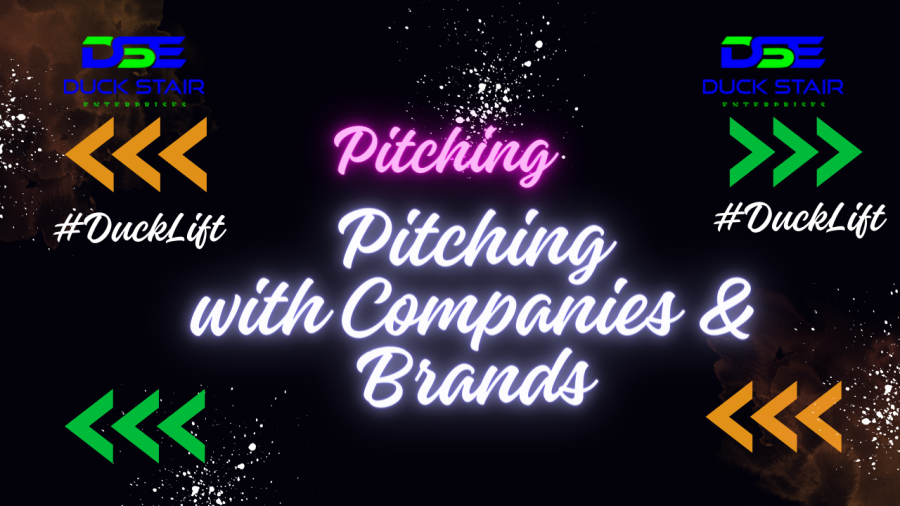1-Pitch with Brands
Pitching to brands involves effectively communicating your value proposition and establishing a mutually beneficial partnership. Whether you’re seeking sponsorship, collaboration, or some other form of partnership, here are steps to help you pitch to brands successfully:
Figure out Your Crowd:
Prior to moving toward any brand, have a reasonable comprehension of your crowd socioeconomics, interests, and commitment. Brands need to understand what their objective market lines up with your listeners might be thinking.
Define Your Value Proposition:
Obviously understandable what you offer that would be useful. Feature your novel selling focuses, reach, and the worth you can propose to the brand.
Explain how your audience and content align with the brand’s goals and values.
Research the Brand:
Know the brand inside out.Figure out its items or administrations, interest group, advertising systems, and any new missions. Tailor your pitch to demonstrate the way that your cooperation can supplement the brand’s current endeavours.
Create a Professional Pitch Deck:
Develop a visually appealing and informative pitch deck. Include key metrics about your audience, engagement rates, past successful collaborations, and any relevant statistics that showcase your reach and impact.
Craft a Compelling Email or Proposal:
In your effort, be compact, yet convincing. Obviously state what your identity is, the reason you’re connecting, and how an organisation with the brand would be valuable together.Attach your pitch deck for more detailed information.
Highlight Past Successes:
On the off chance that you have effectively worked together with different brands or have outstanding accomplishments, share them. This adds validity to your pitch and shows your capacity to convey results.
Propose Customised Ideas:
Tailor your pitch to the specific brand.Propose imaginative and tweaked thoughts for cooperation that line up with the brand’s qualities and targets. Demonstrate the way that you’ve pondered how your organisation can be special and effective.
Be Transparent:
Be straightforward about your assumptions, and obviously frame what you’re giving as a trade off. This incorporates insights regarding expectations, special endeavours, and any remuneration or advantages you’re chasing.
Follow Up Professionally:
On the off chance that you don’t get a prompt reaction, follow up in an expert and pleasant way. Industriousness is vital, however try not to be pushy.
Acknowledge that they may be busy and express your continued interest in working together.
Prepare for Negotiation:
Be ready to arrange terms, particularly assuming the brand communicates interest. Grasp the worth of your contributions and track down a trade off that works for the two players.
Showcase Your Personality:
Marks frequently search for powerhouses or teammates whose character lines up with their own. Allow your character to radiate through in your pitch to provide the brand with a feeling of what your identity is and the way in which you address yourself.
Be Patient and Aware:
Comprehend that brands might have their own timetables and dynamic cycles. Be patient and conscious all through the correspondence, regardless of whether the underlying reaction isn’t as sure as you trusted.
Keep in mind, building associations with brands is in many cases a continuous cycle. Regardless of whether a cooperation happens right away, keeping a positive and expert relationship can prompt future open doors.
2-Pitch with Companies
Pitching to companies involves effectively presenting your ideas, products, or services in a way that demonstrates value and aligns with the company’s needs or goals. Whether you’re pitching a business proposal, a partnership, or a product/service, here are some steps to help you create a compelling pitch:
Research the Company:
Figure out the organisation’s business, mission, values, interest group, and current difficulties. This information will empower you to fit your pitch to address the particular requirements and interests of the organisation.
Recognize Key Leaders:
Figure out who the key chiefs are inside the organisation. Your pitch ought to be coordinated towards those people who have the power to go with choices connected with your proposition.
Craft a Clear Value Proposition:
Obviously lucid the worth your proposition brings to the organisation. Centre around how your item, administration, or thought tends to the organisation’s trouble spots, further develops proficiency, or adds to their general achievement.
Understand Their Goals:
Adjust your pitch to the organisation’s objectives and goals. Obviously exhibit how your proposition upholds their essential drives and assists them with accomplishing unmistakable results.
Customise Your Pitch:
Tailor your pitch to the particular organisation. Try not to utilise a conventional layout and on second thought integrate subtleties that show you’ve gotten your work done. Organisations value pitches that are customised and applicable to their interesting circumstance.
Start with a Strong Introduction:
Catch the organisation’s consideration all along. Obviously state what your identity is, momentarily present your proposition, and feature the key advantages the organisation will acquire from your deal.
Provide Supporting Data and Evidence:
Back up your cases with information, contextual investigations, or tributes that exhibit the viability of your proposition. Numbers and substantial proof can improve the validity of your pitch.
Address Potential Concerns:
Anticipate and address potential concerns or objections the company may have. Show that you’ve thought through potential challenges and have solutions in place.
Use Visuals Effectively:
Use visuals, like diagrams, charts, or infographics, to introduce data in an outwardly engaging and effectively edible configuration. Visual guides can upgrade the effect of your pitch.
Exhibit Profit from Venture (return for capital invested):
Obviously frame the likely profit from venture for the organisation. Whether it’s expense reserve funds, income development, or further developed effectiveness, organisations are bound to draw in on the off chance that they see a positive effect on their primary concern.
Feature Your Mastery and Experience:
Feature your ability, experience, and pertinent achievements. This assists work with trusting and trust in your capacity to follow through on your proposition.
End with a Call to Action:
Obviously express the following stages and give a source of inspiration. Whether it’s booking a subsequent gathering, giving more data, or pushing ahead with the proposed joint effort, guide the organisation in the ideal way.
Follow Up Professionally:
Subsequent to conveying your pitch, circle back to an expert and considerate email or call. Offer your thanks for their time, emphasise central issues from your pitch, and ask about any extra data they might require.
Recollect that powerful correspondence, personalization, and an emphasis on tackling the organisation’s particular difficulties are key components of an effective pitch to organisations.
























